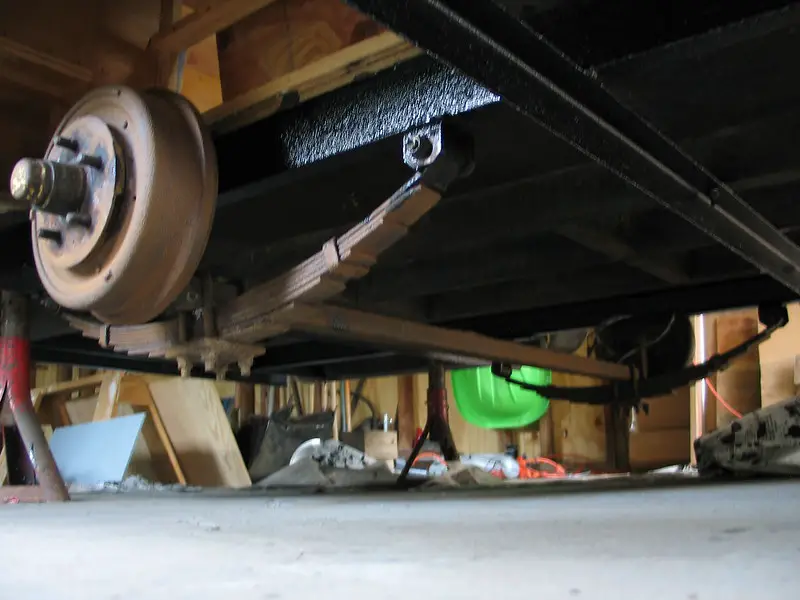Owning a trailer is a lot like owning a second home, but it presents a unique set of challenges. For example, you’ll never bottom out your house, but you could very well bottom out your trailer. Whenever this happens, you run the risk of damaging the undercarriage. Understandably, many people wonder whether they can lift their leaf spring suspension for greater clearance.
If your leaf springs are currently overslung, you can lift your trailer by converting the suspension to an underslung setup. However, if your slings are already underslung, your only option is to use taller hangers. Otherwise, you will not be able to use a lift kit to lift your trailer.
In this guide, I’ll walk you through 7 important things that you should know about lifting a trailer with leaf springs. Depending on your trailer’s current suspension, you may be able to add a few more inches of clearance to help keep you from bottoming out.
Don’t forget to check out our Recommended RV Equipment list!
1. You Probably Only Need a Few Extra Inches of Clearance
We only recommend lifting your trailer if it improves the ride. If you’re worried about bottoming out your trailer, you may be tempted to add a few extra inches of clearance to be safe. However, this is usually unnecessary and can make towing your trailer more difficult.
Most trailers only need between 12 and 16 inches of clearance from the ground. Any more than that, and you run the risk of damaging your trailer or making it difficult to tow. The higher you lift the rig, the more you’ll shift the center of gravity, and if you raise it too high, you may find that it sits at an odd angle.
If you are confident that your trailer needs to be lifted, start small by adding just a few inches. 2 or 3 extra inches of clearance makes a big difference without upsetting your trailer’s natural center of gravity.
2. How Leaf Springs Work
Leaf springs are a type of spring that is typically used in a trailer and fifth-wheel suspension systems. Leaf springs are made up of several metal leaves, which are then stacked on top of each other and connected to using a system of bolts or clips. The leaves flex and absorb the impact whenever your trailer hits a bump.
This type of spring is often used in trailer suspension systems because they offer several benefits. For example, they are straightforward and inexpensive to manufacture while still helping to absorb shock and protect the trailer and its contents from damage. Leaf springs also help distribute weight evenly, which can improve the trailer’s handling.
If you are unsure if your trailer uses leaf springs, it’s pretty easy to tell. Roll yourself under your trailer and check the springs attached to your trailer’s axles. If you see a series of metal plates stacked on top of each other in varying sizes, your camper has a set of leaf springs.
3. Replacing Old Leaves Can Lift Your Trailer
If you’re unsatisfied with the amount of clearance your trailer has, it could be a problem with the existing springs. If they’ve become worn out, they could be sagging and causing your trailer to droop.
By replacing worn-out leaves or simply adding more, your trailer will ride more smoothly over speed bumps and rugged terrain without shaking the trailer’s interior. However, they’ll only add a slight height difference.
To add more leaves, follow these steps:
- Jack your trailer onto a set of stands and remove both wheels from one of the axles. You should be able to see the hangers holding your leaf springs in place on either side of the axle.
- The hangers should have space through which you can feed the eyes of a new spring before securing the added spring in place. Using thicker leaves will add some lift to your trailer, though only slightly.
- Once you’ve connected the springs into place, install U-bolts to improve their functionality. This bolt should go around the axle and hold the springs tightly into place along with the axle. There shouldn’t be any movement when you start driving.
- While you replace the springs, also be sure to check the shackle links. Over time, these links can wear away, creating a ring that resembles a nut. If the ring appears more oval in shape, you’ll need to replace the shackle link.
The real trick is to add enough height that you can install bigger tires. Once you’re able to put upgraded tires on your trailer, you’ll gain a noticeable lift from the ground. However, if new springs don’t provide enough extra space, you may need to move on to a suspension lift kit.
4. Overslung vs. Underslung Springs
Leaf springs can be installed in two different formats—overslung and underslung. The design and positioning of your leaf springs will determine whether or not you can lift your trailer’s suspension, so it’s very important that you check before purchasing anything.
Underslung springs are the more common type of leaf spring and are typically found in lighter trailers. This type of spring is designed so that the axle is positioned higher, with the spring literally hanging beneath it. This type of suspension is usually easier to handle and creates a smoother ride since there’s less give in the system.
If your trailer has underslung leaf springs, you may be able to convert the suspension to an overslung setup. This will require you to replace the leaf springs and hangers before installing them below the axel. However, this is not a simple task and should only be attempted by someone with experience.
Overslung leaf springs are less common but are typically found in heavier trailers. Unlike underslung springs, overslung springs have the axle positioned below the spring. This type of leaf spring offers a number of benefits, such as improved stability and more give, allowing for a comfortable ride on uneven roads.
Unfortunately, the only way to add more clearance to an overslung spring is to either replace the entire suspension or add taller hangers. Since the axle is already lower than the springs, moving the position of the springs will not affect the height.
5. Hangers Can Make All the Difference
For leaf springs to work correctly, they need to be well mounted using a set of hangers. Hangers are metal brackets that are attached to the frame of your trailer. The leaf springs are then mounted to the hangers using a system of bolts and clips. Whether your trailer uses overslung or underslung springs, the axle then sits below or above the hangers.
If your axles are held in place below the springs, the length of your hangers can make a big difference. Shorter hangers will naturally sit lower to the ground, reducing the clearance you get. However, changing short hangers for slightly taller hangers will pull the axles higher up into your trailer and give you a few extra inches of clearance.
6. Installing Lift Blocks Between the Springs and Axles
If you’re still unsatisfied with the amount of lift your trailer has, you’ll need to install a set of lift blocks between the springs and axles. Keep in mind, though, that you’ll only be able to do so if your springs are overslung. If they’re in an underslung position, you won’t be able to add blocks.
A lift block will add a bit more space between your springs and axle, giving enough clearance for you to add bigger tires and a few more inches of raw clearance. You’ll also have to add taller U-bolts and hangers to accommodate the blocks with more room.
Additionally, use a traction bar while installing lift blocks between your springs and axles. Placing a block between the two parts can lead to axle wrap, which is when your rear axle tries to rotate in the wrong direction. Adding traction will keep the axle spinning correctly and guarantee that the block stays in place.
7. The Pros of Lifting Your Trailer
Lifting your trailer won’t be an easy task, but there are many benefits to doing so. Most importantly, you’ll gain added clearance, helping to prevent damage to your trailer’s undercarriage. Additionally, replacing worn-out leaf springs will make your trailer ride more smoothly and improve comfort for everyone inside.
Take your time, and be sure to lift your trailer correctly. If you’re struggling with your leaf springs, speak with a professional and save yourself the hassle.
The Bottom Line
Lifting your trailer is a great way to add a few extra inches of clearance and prevent damage to your trailer’s undercarriage. However, it’s important to do so carefully and ensure that your trailer can benefit from the added height. If you’re not sure whether or not your trailer needs to be lifted, speak with a professional to get their opinion.
Don’t forget to check out our Recommended RV Equipment list!
Get a FREE copy of the Go Together Go Far Travel Trailer Hookup and Disconnect Checklist when you sign up for the Go Together Go Far Newsletter!
Want to learn more about different types of RVs? Check out:
- Best Off-Road Camper Trailer Under $10,000
- Best Bunkhouse Travel Trailer Under 30 Feet
- Are Lance Travel Trailers Any Good?
- Do Rope Lights Deter Rodents?
- What Are the Best Names in the RV Industry?
- 3 Best Travel Trailers for Family of Four
- Blue Ox SwayPro Basics: Top Questions Answered
- Adding A Washer Dryer To Travel Trailer? What You Need To Know.
- Best Drone For Camping, Backpacking, and RVing: A Complete Guide to Drones for RVers
- Furniture and RVs – How To Get It Through the Door…
- How To Get Rid Of A Poop Pyramid In RV Black Tank
- Do You Know How Long To Keep Fresh Water In RV Tank Storage?
- What Is The Best Outdoor Security Camera System For Your RV?
- RV Bumper Mount Grills: 5 Best Options For Your RV Or Camper
- Best Electric Tankless Water Heater for Your RV. What You Need To Know
- Read Before You Buy! How to Find the Best Scooter for RV Camping
- 3 Best Travel Trailers for Family of Four
- Top RV Brands: What Are the Best Names in the RV Industry?
- Lance Campers: What Makes Them So Different?
- Best Bunkhouse Travel Trailer Under 30 Feet
- Best Off-Road Camper Trailer Under $10,000
- Best Weight Distribution Hitch With Sway Control For Travel Trailers in 2022
- What Are The Best Built Travel Trailers? Things To Consider.
- How Does An RV Refrigerator Work? A Quick Guide.
- Why Does My RV Carbon Monoxide Detector Keep Beeping? A Quick Guide.
- Where Is The Power Converter In My RV Or Travel Trailer
- What is the Best Generator for 50 Amp RV?
- Wireless RV Security Camera Systems: Is Solar Powered Security Without Wi-Fi An Option?
- Best Portable Air Conditioner for Camping for 2022
- How to Find the Best 3500 Watt Inverter Generator for RV Camping
- Best Propane Generator For Your RV: Read This Before You Buy!


